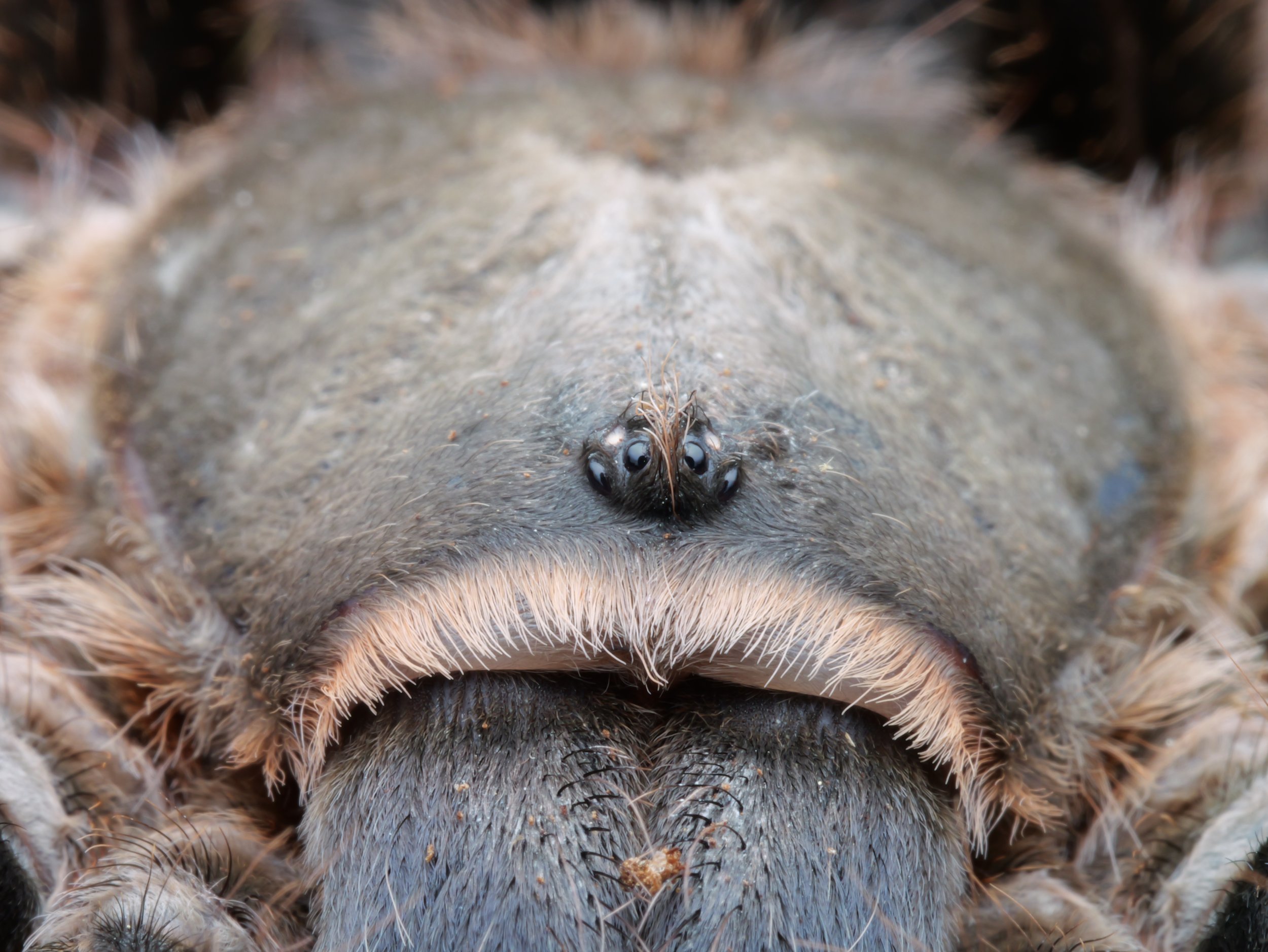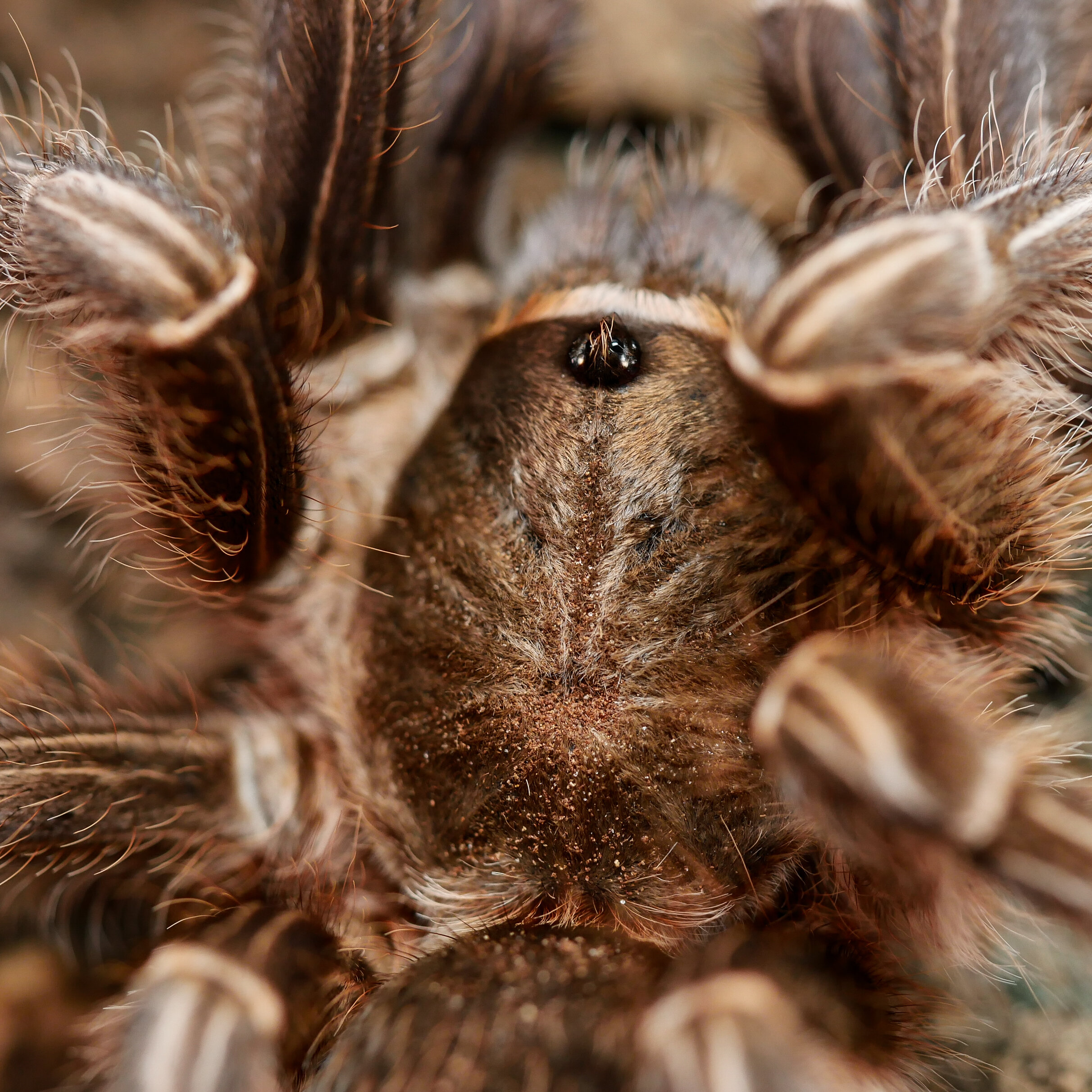Costa Rican Zebra Tarantula
Aphonopelma seemanni
Care Sheet
Costa Rican Zebra Care Video
Aphonopelma seemanni Care Guide
The Costa Rican Zebra Tarantula
Revision Date: March 2025
Introduction
Today we’re focusing on Aphonopelma seemanni, also known as the Costa Rican Zebra or Striped Knee Tarantula. Hailing from the dry forests of Central America, found in Costa Rica, Honduras, Nicaragua, and possibly Guatemala, this species is admired for its distinctive dark brown body adorned with white or beige stripes along its legs. With a calm demeanor and a natural tendency to retreat into its burrow, this tarantula is an excellent choice for beginners who appreciate a more private, low-maintenance pet.
Quick Species Snapshot
Scientific Name: Aphonopelma seemanni
Common Names: Costa Rican Zebra Tarantula, Striped Knee Tarantula
Type: Terrestrial, Opportunistic Burrower
Native Range: Costa Rica, Honduras, Nicaragua (possibly Guatemala and other parts of Central America)
Body Length: Approximately 3.5” (9 cm)
Diagonal Leg Span (DLS): 5-6” (15 cm)
Growth Rate: Slow
Life Expectancy: Females up to 20 years; Males 5-10 years
Experience Level: Beginner
What Makes A. seemanni So Special?
The Costa Rican Zebra Tarantula is distinguished by its striking dark brown coat with contrasting white or beige stripes along its legs, giving it a “zebra-like” appearance. While it tends to be more reserved and private, preferring to stay hidden in its burrow, it comes out to feed or explore when conditions are favorable. Its calm temperament and modest defensive behaviors (as it is more likely to retreat than to display overt aggression) make it an ideal pet for those new to the hobby.
A Species at Risk
Although not currently endangered, Aphonopelma seemanni relies on its natural burrows for security and well-being. Captive care should aim to replicate these conditions to minimize stress and potential health issues. Responsible sourcing of captive-bred specimens from reputable dealers is always recommended.
Natural Habitat & What That Means for Enclosure Setup
In the wild, Aphonopelma seemanni thrives in the dry forests and scrublands of Central America, where it digs deep burrows to escape temperature extremes and maintain humidity. Successfully keeping this species in captivity means replicating those natural conditions as closely as possible.
Burrowing Needs: This species is an enthusiastic burrower, so providing a deep layer of substrate is essential. A minimum of 4–6 inches of substrate will allow it to create a stable burrow, reducing stress and encouraging natural behaviors. Without a proper burrowing setup, some individuals may attempt to climb the enclosure walls, which can be risky for a terrestrial species.
Moisture Control: While A. seemanni is often associated with arid regions, it actually prefers a bit more moisture than some other Aphonopelma species. Spiderlings should have slightly damp substrate to prevent dehydration, while juveniles and adults do best with a well-draining setup where the substrate is allowed to dry out between waterings. Avoid excessive moisture, as stagnant conditions can lead to mold or mite issues.
Space & Security: Providing a secure, spacious enclosure will help minimize stress and encourage natural behavior. While they appreciate the ability to burrow, A. seemanni is also known to be more active than some other terrestrial species, sometimes exploring the enclosure at night. A secure hide is recommended in addition to deep substrate, giving the tarantula a backup retreat if it hasn’t yet constructed a burrow.
By recreating the natural environment of Aphonopelma seemanni, keepers can ensure a healthy, stress-free tarantula that exhibits its full range of fascinating behaviors.
Housing & Substrate – Terrestrial Setup
Spiderlings
Enclosure Size:
Use a small acrylic enclosure (e.g., Sling Crib, 3" Tarantula Cube, Small Slider Crib, Small Cuboid, Terrestrial Sling Crib, Slider Crib Mini, or Cuboid Mini) that is no smaller than three times the tarantula’s leg span. We recommend enclosures by Tarantula Cribs for their proven quality and safety.Substrate:
Fill at least 2/3rds of the enclosure with Terra Aranea by The Bio Dude.Humidity:
Maintain a slightly damp substrate (but not swampy) by offering a small water dish or gently dripping water on one corner about once a week.
Juveniles
Enclosure Size:
Use a medium enclosure (e.g., Medium Slider Crib, 6" or 8" Tarantula Cube, or Medium Cuboid) that is at least 3–4× the tarantula’s leg span.Substrate:
Fill the enclosure 1/2 to 2/3 full with Terra Aranea by The Bio Dude. This depth ensures ample space for burrowing while minimizing the risk of injury from falls.Humidity:
Keep the substrate mostly dry with a full water dish; occasionally overflow one corner to create a slightly damp area.Additional Features:
Provide a half cork bark round for a secure hide.
Adults
Enclosure Size:
Use a large enclosure (e.g., Large Slider Crib, 12" Cube Switch, 12" Cube, 18" Cube, or Terrestrial XL) that is at least 3× the tarantula’s leg span (ideally 4× for enhanced natural behavior, while considering escape risks). Enclosures by Tarantula Cribs are highly recommended.Substrate:
Fill the enclosure 1/2 to 2/3 full with Terra Aranea by The Bio Dude to provide sufficient depth for burrowing while reducing the risk of falls.Additional Features:
Include a secure hide (preferably a half cork bark round) and a shallow water dish. Ensure the enclosure is a horizontal rectangle (wider than it is deep) with secure ventilation and a tight, secure lid to prevent escapes.
Note:
The general rule of thumb for tarantula enclosures is that the enclosure should be no smaller than three times the tarantula’s leg span for spiderlings, 3–4× for juveniles, and 3–4× for adults. This ensures ample space for natural burrowing while minimizing fall risk. Remember, tarantulas are escape artists—always verify that ventilation holes, lids, and gaps are too small for your tarantula to squeeze through. They can and will climb glass and other smooth surfaces.Affiliate: Please use Tarantula Cribs (affiliate code TTC10) and Terra Aranea by The Bio Dude for substrate.
Temperature & Humidity
Temperature: Maintain ambient temperatures between 68°F and 76°F (20-24°C).
Humidity: Aim for moderate humidity. Spiderlings may require slightly damp substrate, while juveniles and adults thrive with substrate that dries out between waterings.
Feeding Schedule
Spiderlings
Frequency: Feed twice a week
Prey: Offer small prey such as flightless fruit flies, confused flour beetles, or pre-killed tiny crickets/roach nymphs. Remove any uneaten prey after 24 hours. increase the size of the prey as the spider grows. Prekill any prey that is over 2/3 the size of the sling. For more detailed information on feeding spiderlings, watch this video: How To Feed Spiderlings & Scorplings (Baby Tarantulas & Scorpions)
Post-Molt: Wait 2-3 days after a molt before feeding.
Juveniles
Frequency: Feed every 10–14 days
Prey: Provide 2–3 small to medium crickets. Adjust the quantity based on the tarantula’s abdomen size.
Note: If the tarantula appears thin, you may offer food a bit more frequently; if its abdomen is wider than its carapace, reduce feeding.
Adults
Frequency: Feed every 3–4 weeks (or as needed)
Prey: Offer 4–5 adult crickets. Keep an eye on their abdomen size—if it’s wider than the carapace, wait until it normalizes before feeding again.
Post-Molt: Allow adequate time for the tarantula to fully harden after molting before offering food.
Feeding Guidelines:
Adjust feeding frequency based on the tarantula’s abdomen size relative to its carapace. Smaller abdomens may indicate a need for more frequent feedings, while larger abdomens suggest reducing feeding frequency to avoid health issues.
Behavior & Temperament
Aphonopelma seemanni is known for its relatively docile nature and tendency to remain hidden within its burrow. While not typically aggressive, it is somewhat skittish and may retreat when disturbed, especially during rehousing. Generally, it does not exhibit overt defensive behaviors such as kicking hairs; instead, it relies on its natural inclination to hide. Respecting its space is key to keeping this tarantula comfortable.
Breeding Aphonopelma seemanni in Captivity
Breeding Aphonopelma seemanni (Costa Rican Zebra Tarantula) can be challenging due to their secretive nature and occasional aggression toward males. However, with careful planning and the right environmental conditions, successful breeding is possible. Captive breeding is especially important to help reduce the demand for wild-caught specimens, ensuring that this species remains available in the hobby without harming natural populations.
Sexual Maturity & Pairing
Male Maturity: Males typically mature within 4–7 years, developing tibial hooks and enlarged pedipalps for sperm transfer.
Female Maturity: Females take longer, often 8–10 years, before they are fully mature and receptive.
Pre-Pairing Preparation: Females should be well-fed before pairing to reduce the risk of aggression. Some breeders also recommend increasing humidity slightly to mimic the rainy season, which may encourage receptivity.
Mating Process
Introduce the male at night, as they are more likely to engage in courtship when active.
The male will drum on the substrate to signal his presence.
If receptive, the female may drum back or remain still, allowing the male to lift her with his tibial hooks and insert his emboli.
Once mating is complete, the male should be removed immediately, as A. seemanni females can be highly aggressive post-mating.
Egg Sac Production
If fertilization is successful, the female will begin producing an egg sac 4–6 months after mating.
Maintain temperatures around 72–78°F (22–25°C) and humidity levels of 65–75%, as this species naturally prefers a more humid environment. (see Challenges & Considerations section)
The female will guard the egg sac, which typically contains 200–600 eggs.
Egg Sac Handling (Optional)
Some breeders choose to pull the egg sac after 30–45 days to artificially incubate it.
If left with the mother, 1st instar spiderlings will emerge in 8–10 weeks and molt into 2nd instar after another 3–4 weeks.
Raising Spiderlings
Once they reach 2nd instar, separate them into individual enclosures.
Feed them pinhead crickets, flightless fruit flies, or small roaches every 3–4 days.
Challenges & Considerations
Female aggression: A. seemanni can be particularly aggressive toward males after mating, so careful supervision is essential.
Burrowing behavior: Females often bury themselves for extended periods post-mating, which can make monitoring difficult.
Humidity sensitivity: This species requires higher humidity than many other Aphonopelma species, so conditions should be monitored carefully.
Male lifespan: Males typically do not live more than a year after maturing, so breeding should be attempted as soon as possible.
Winter Diapause Required for Egg Sac Production: Unlike many other tarantulas, Aphonopelma species require a winter diapause to trigger consistent egg sac production. This means exposing them to cooler temperatures for several months to mimic their natural seasonal cycle.
Spring Feeding and Humidity Increase: As temperatures rise in the spring, females should be fed heavily and humidity should be increased to simulate natural conditions. If gravid, they will typically begin producing an egg sac a few weeks later.
Long Timeline from Pairing to Egg Sac: The entire process from pairing to egg sac production typically takes around six months, making patience and seasonal adjustments critical for success.
The Costa Rican Zebra Tarantula is often collected from the wild for the pet trade, but this is unnecessary when captive breeding is successful. By supporting captive breeding efforts, we can help reduce pressure on wild populations, ensuring a steady supply of healthy, well-adjusted specimens for the hobby. Breeding in captivity also allows for greater control over genetic diversity and overall tarantula health.
Final Thoughts
If you’re looking for a unique and underrated species, the Costa Rican Zebra Tarantula (Aphonopelma seemanni) is a fantastic choice. Its sleek black body accented with striking white leg striping makes it one of the more visually impressive Aphonopelma species, while its hardy nature and low-maintenance care requirements make it an excellent option for both beginners and seasoned keepers. Though it can be a bit reclusive, spending much of its time in or near its burrow, patient keepers will appreciate its fascinating behaviors and occasional nighttime explorations.
The Story Behind the Name
The species name seemanni honors Danish entomologist and naturalist Berthold Carl Seemann, who contributed significantly to the study of Central American flora and fauna in the 19th century. This connection highlights the species’ deep roots in the diverse ecosystems of Costa Rica and beyond.
Observing Natural Behaviors
One of the most rewarding aspects of keeping A. seemanni is watching it exhibit its natural burrowing instincts. Unlike some terrestrial tarantulas that prefer to lounge in the open, this species thrives when given the opportunity to dig deep and establish a secure retreat. With a proper setup that includes deep, slightly moist substrate and a well-ventilated enclosure, A. seemanni can live a long, stress-free life, rewarding keepers with occasional appearances and the satisfaction of providing an ideal habitat.
Why Keep Aphonopelma seemanni?
Although it may not be as flashy or active as some species, the Costa Rican Zebra Tarantula has a charm all its own. Its striking contrast of dark and light markings, combined with its calm yet reclusive nature, makes it an intriguing species to observe. Given its long lifespan, females can live well over two decades, this is a species that requires patience but ultimately provides a fascinating glimpse into the secretive world of burrowing tarantulas.
Additional Recommendations
For enclosures, I recommend Tarantula Cribs, which offer high-quality, well-ventilated setups perfect for this species. Be sure to use affiliate code TTC10 for 10% off. When it comes to substrate, I highly suggest using Terra Aranea by The Bio Dude, as it holds moisture well and supports burrowing behavior.
If you’re looking to purchase Aphonopelma seemanni or other tarantulas online, check out Spider Shoppe, where you can use code TTC10 for 10% off. Also, visit the Dealer & Discounts section on my website for a curated list of other trusted breeders and exclusive discounts.
Zebra Knee Enclosure Build
A BRIEF HISTORY of Tarantulas
Where did tarantulas come from? When did spiders and tarantulas first evolve? Let's start from the beginning and trace the evolution of tarantulas from first emerging from the water and adapting to life on land all the way to present-day tarantulas!
Tarantulas on the Brink of EXTINCTION
As the popularity of tarantula keeping skyrockets, it's time to confront the harsh truth: many tarantula species are facing threats of extinction in the wild. In this discussion, we explore the primary factors contributing to their declining populations and the urgent need for action.


























